park assist TOYOTA BZ4X 2022 Owners Manual (in English)
[x] Cancel search | Manufacturer: TOYOTA, Model Year: 2022, Model line: BZ4X, Model: TOYOTA BZ4X 2022Pages: 674, PDF Size: 120.02 MB
Page 6 of 674
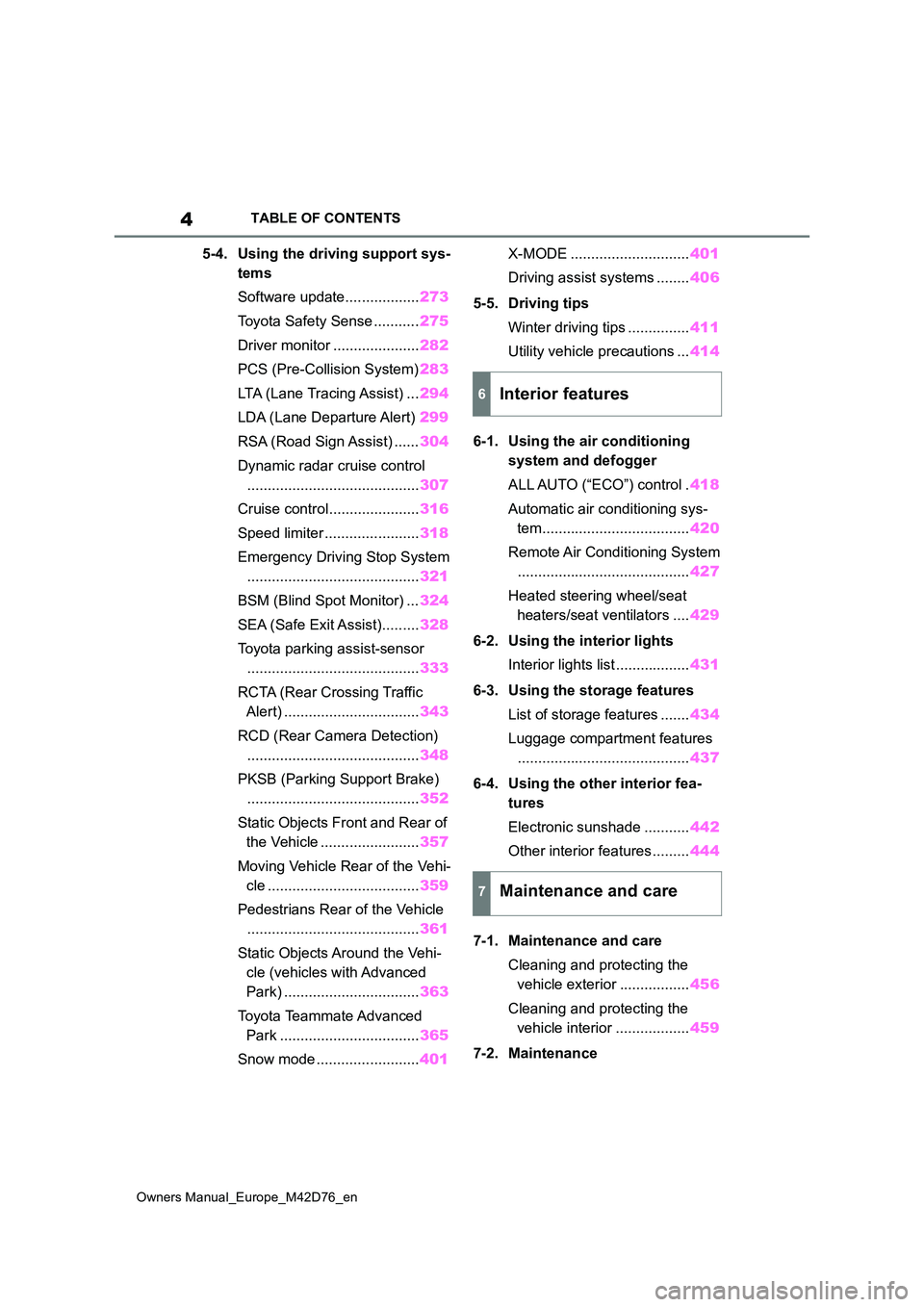
4
Owners Manual_Europe_M42D76_en
TABLE OF CONTENTS
5-4. Using the driving support sys-
tems
Software update.................. 273
Toyota Safety Sense ........... 275
Driver monitor ..................... 282
PCS (Pre-Collision System) 283
LTA (Lane Tracing Assist) ... 294
LDA (Lane Departure Alert) 299
RSA (Road Sign Assist) ...... 304
Dynamic radar cruise control
.......................................... 307
Cruise control...................... 316
Speed limiter ....................... 318
Emergency Driving Stop System
.......................................... 321
BSM (Blind Spot Monitor) ... 324
SEA (Safe Exit Assist)......... 328
Toyota parking assist-sensor
.......................................... 333
RCTA (Rear Crossing Traffic
Alert) ................................. 343
RCD (Rear Camera Detection)
.......................................... 348
PKSB (Parking Support Brake)
.......................................... 352
Static Objects Front and Rear of
the Vehicle ........................ 357
Moving Vehicle Rear of the Vehi-
cle ..................................... 359
Pedestrians Rear of the Vehicle
.......................................... 361
Static Objects Around the Vehi-
cle (vehicles with Advanced
Park) ................................. 363
Toyota Teammate Advanced
Park .................................. 365
Snow mode ......................... 401
X-MODE ............................. 401
Driving assist systems ........ 406
5-5. Driving tips
Winter driving tips ............... 411
Utility vehicle precautions ... 414
6-1. Using the air conditioning
system and defogger
ALL AUTO (“ECO”) control . 418
Automatic air conditioning sys-
tem.................................... 420
Remote Air Conditioning System
.......................................... 427
Heated steering wheel/seat
heaters/seat ventilators .... 429
6-2. Using the interior lights
Interior lights list .................. 431
6-3. Using the storage features
List of storage features ....... 434
Luggage compartment features
.......................................... 437
6-4. Using the other interior fea-
tures
Electronic sunshade ........... 442
Other interior features ......... 444
7-1. Maintenance and care
Cleaning and protecting the
vehicle exterior ................. 456
Cleaning and protecting the
vehicle interior .................. 459
7-2. Maintenance
6Interior features
7Maintenance and care
Page 43 of 674
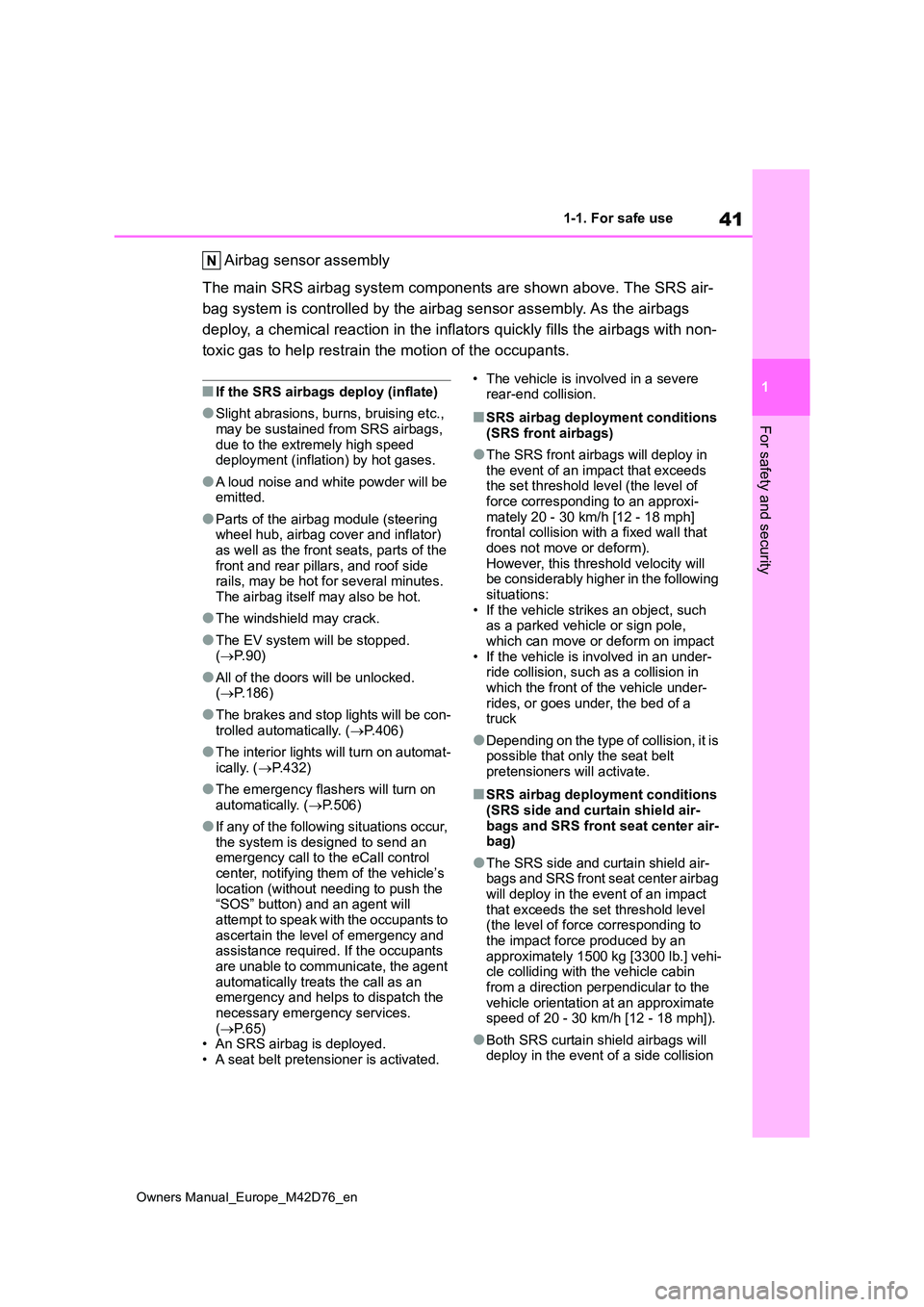
41
1
Owners Manual_Europe_M42D76_en
1-1. For safe use
For safety and security
Airbag sensor assembly
The main SRS airbag system components are shown above. The SRS air-
bag system is controlled by the airbag sensor assembly. As the airbags
deploy, a chemical reaction in the inflators quickly fills the airbags with non-
toxic gas to help restrain the motion of the occupants.
■If the SRS airbags deploy (inflate)
●Slight abrasions, burns, bruising etc.,
may be sustained from SRS airbags, due to the extremely high speed deployment (inflation) by hot gases.
●A loud noise and white powder will be emitted.
●Parts of the airbag module (steering wheel hub, airbag cover and inflator)
as well as the front seats, parts of the front and rear pillars, and roof side rails, may be hot for several minutes.
The airbag itself may also be hot.
●The windshield may crack.
●The EV system will be stopped. ( P. 9 0 )
●All of the doors will be unlocked. ( P.186)
●The brakes and stop lights will be con-
trolled automatically. ( P.406)
●The interior lights will turn on automat-
ically. ( P.432)
●The emergency flashers will turn on
automatically. ( P.506)
●If any of the following situations occur,
the system is designed to send an emergency call to the eCall control center, notifying them of the vehicle’s
location (without needing to push the “SOS” button) and an agent will attempt to speak with the occupants to
ascertain the level of emergency and assistance required. If the occupants are unable to communicate, the agent
automatically treats the call as an emergency and helps to dispatch the necessary emergency services.
( P. 6 5 ) • An SRS airbag is deployed.• A seat belt pretensioner is activated.
• The vehicle is involved in a severe rear-end collision.
■SRS airbag deployment conditions
(SRS front airbags)
●The SRS front airbags will deploy in
the event of an impact that exceeds the set threshold level (the level of force corresponding to an approxi-
mately 20 - 30 km/h [12 - 18 mph] frontal collision with a fixed wall that does not move or deform).
However, this threshold velocity will be considerably higher in the following situations:
• If the vehicle strikes an object, such as a parked vehicle or sign pole, which can move or deform on impact
• If the vehicle is involved in an under- ride collision, such as a collision in which the front of the vehicle under-
rides, or goes under, the bed of a truck
●Depending on the type of collision, it is possible that only the seat belt pretensioners will activate.
■SRS airbag deployment conditions
(SRS side and curtain shield air- bags and SRS front seat center air-bag)
●The SRS side and curtain shield air-bags and SRS front seat center airbag
will deploy in the event of an impact that exceeds the set threshold level (the level of force corresponding to
the impact force produced by an approximately 1500 kg [3300 lb.] vehi-cle colliding with the vehicle cabin
from a direction perpendicular to the vehicle orientation at an approximate speed of 20 - 30 km/h [12 - 18 mph]).
●Both SRS curtain shield airbags will deploy in the event of a side collision
Page 171 of 674
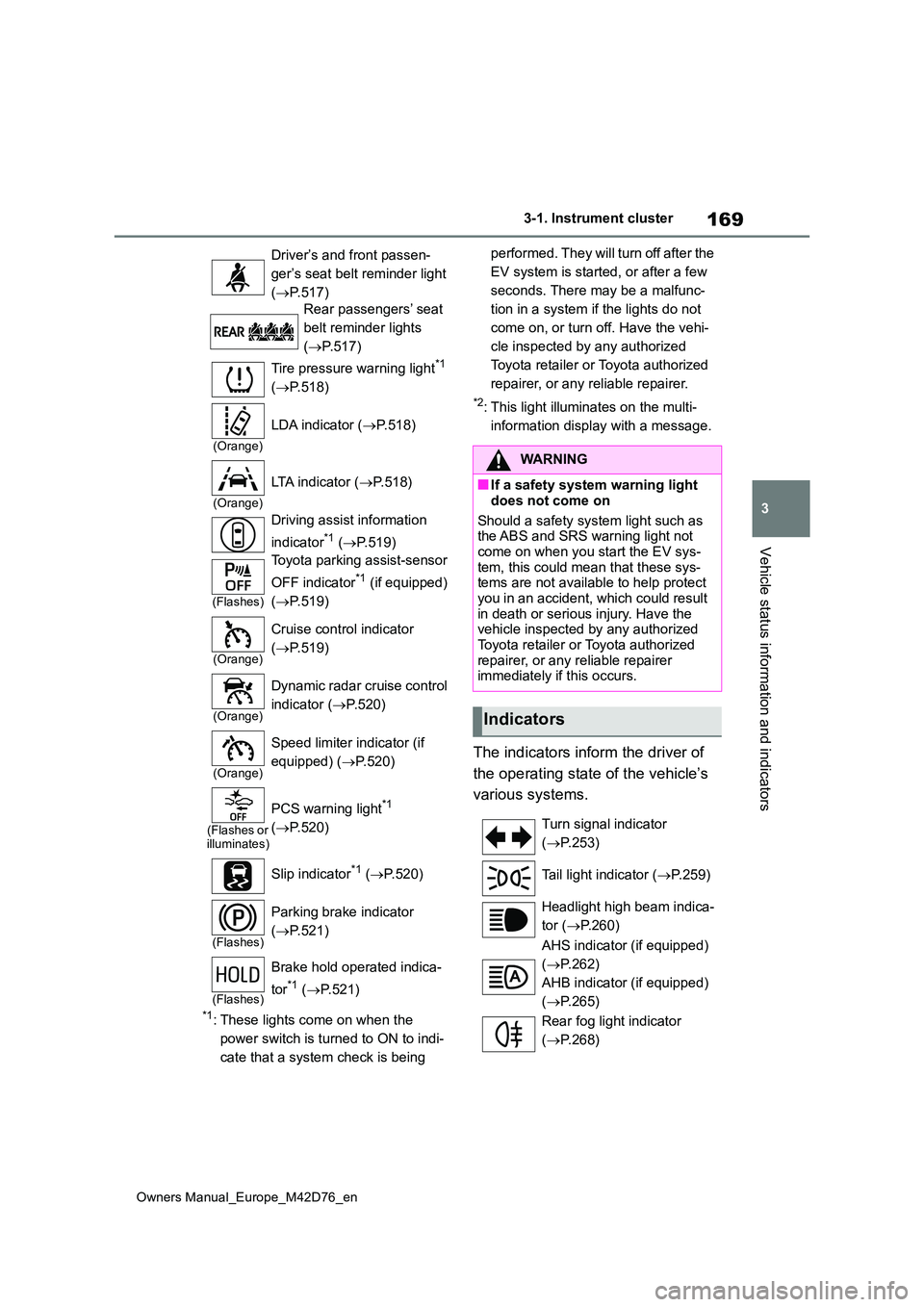
169
3
Owners Manual_Europe_M42D76_en
3-1. Instrument cluster
Vehicle status information and indicators
*1: These lights come on when the
power switch is turned to ON to indi-
cate that a system check is being
performed. They will turn off after the
EV system is started, or after a few
seconds. There may be a malfunc-
tion in a system if the lights do not
come on, or turn off. Have the vehi-
cle inspected by any authorized
Toyota retailer or Toyota authorized
repairer, or any reliable repairer.
*2: This light illuminates on the multi-
information display with a message.
The indicators inform the driver of
the operating state of the vehicle’s
various systems.
Driver’s and front passen-
ger’s seat belt reminder light
( P.517)
Rear passengers’ seat
belt reminder lights
( P.517)
Tire pressure warning light*1
( P.518)
(Orange)
LDA indicator (P.518)
(Orange)
LTA indicator (P.518)
Driving assist information
indicator*1 ( P.519)
(Flashes)
Toyota parking assist-sensor
OFF indicator*1 (if equipped)
( P.519)
(Orange)
Cruise control indicator
( P.519)
(Orange)
Dynamic radar cruise control
indicator ( P.520)
(Orange)
Speed limiter indicator (if
equipped) ( P.520)
(Flashes or illuminates)
PCS warning light*1
( P.520)
Slip indicator*1 ( P.520)
(Flashes)
Parking brake indicator
( P.521)
(Flashes)
Brake hold operated indica-
tor*1 ( P.521)
WARNING
■If a safety system warning light
does not come on
Should a safety system light such as the ABS and SRS warning light not
come on when you start the EV sys- tem, this could mean that these sys-tems are not available to help protect
you in an accident, which could result in death or serious injury. Have the vehicle inspected by any authorized
Toyota retailer or Toyota authorized repairer, or any reliable repairer immediately if this occurs.
Indicators
Turn signal indicator
( P.253)
Tail light indicator ( P.259)
Headlight high beam indica-
tor ( P.260)
AHS indicator (if equipped)
( P.262)
AHB indicator (if equipped)
( P.265)
Rear fog light indicator
( P.268)
Page 172 of 674
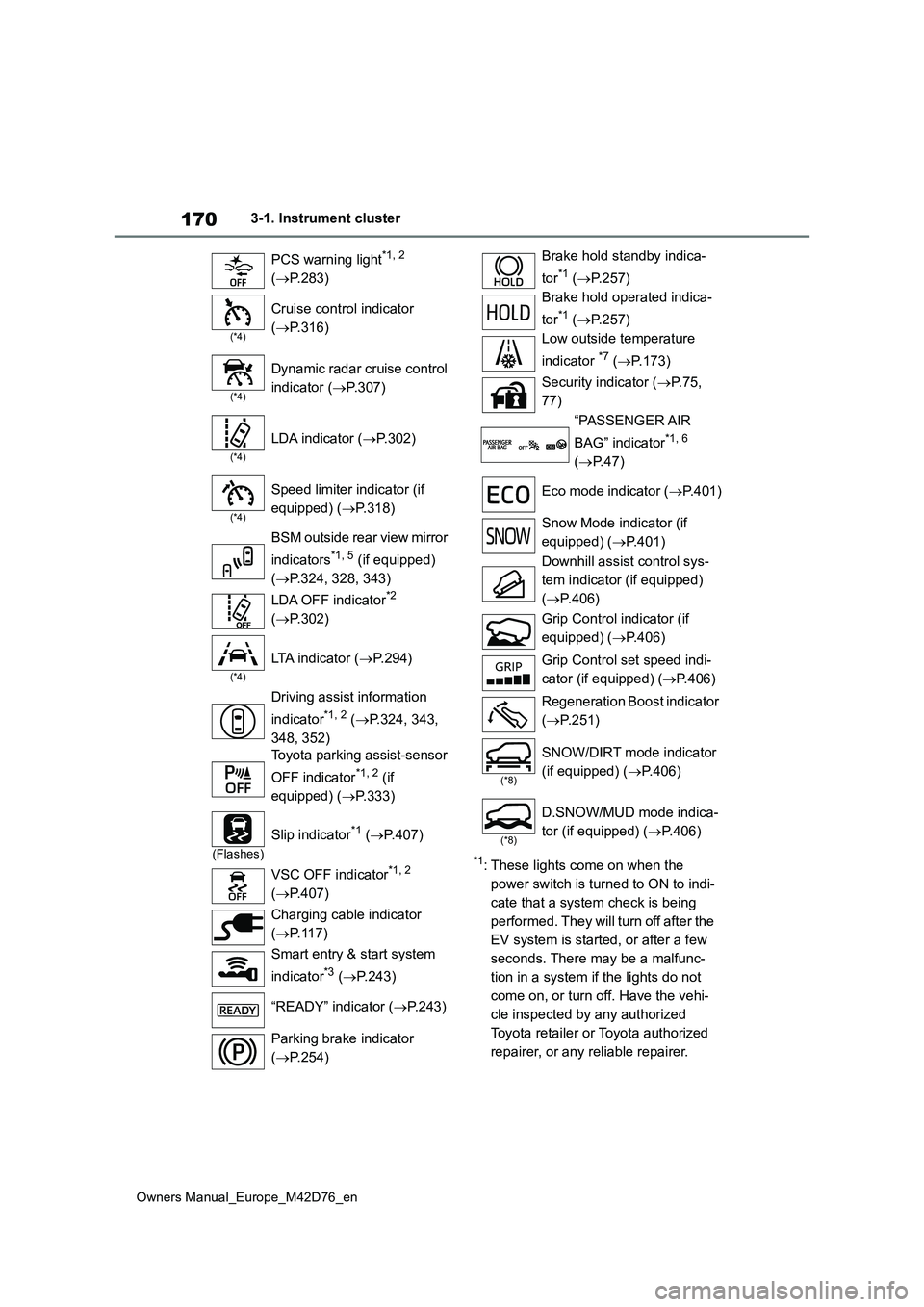
170
Owners Manual_Europe_M42D76_en
3-1. Instrument cluster
*1: These lights come on when the
power switch is turned to ON to indi-
cate that a system check is being
performed. They will turn off after the
EV system is started, or after a few
seconds. There may be a malfunc-
tion in a system if the lights do not
come on, or turn off. Have the vehi-
cle inspected by any authorized
Toyota retailer or Toyota authorized
repairer, or any reliable repairer.
PCS warning light*1, 2
( P.283)
(*4)
Cruise control indicator
( P.316)
(*4)
Dynamic radar cruise control
indicator ( P.307)
(*4)
LDA indicator (P.302)
(*4)
Speed limiter indicator (if
equipped) ( P.318)
BSM outside rear view mirror
indicators*1, 5 (if equipped)
( P.324, 328, 343)
LDA OFF indicator*2
( P.302)
(*4)
LTA indicator (P.294)
Driving assist information
indicator*1, 2 ( P.324, 343,
348, 352)
Toyota parking assist-sensor
OFF indicator*1, 2 (if
equipped) ( P.333)
(Flashes)
Slip indicator*1 (P.407)
VSC OFF indicator*1, 2
( P.407)
Charging cable indicator
( P. 1 1 7 )
Smart entry & start system
indicator*3 ( P.243)
“READY” indicator ( P.243)
Parking brake indicator
( P.254)
Brake hold standby indica-
tor*1 ( P.257)
Brake hold operated indica-
tor*1 ( P.257)
Low outside temperature
indicator *7 ( P.173)
Security indicator ( P. 7 5 ,
77)
“PASSENGER AIR
BAG” indicator*1, 6
( P.47)
Eco mode indicator ( P. 4 0 1 )
Snow Mode indicator (if
equipped) ( P.401)
Downhill assist control sys-
tem indicator (if equipped)
( P.406)
Grip Control indicator (if
equipped) ( P.406)
Grip Control set speed indi-
cator (if equipped) ( P.406)
Regeneration Boost indicator
( P.251)
(*8)
SNOW/DIRT mode indicator
(if equipped) ( P.406)
(*8)
D.SNOW/MUD mode indica-
tor (if equipped) ( P.406)
Page 207 of 674
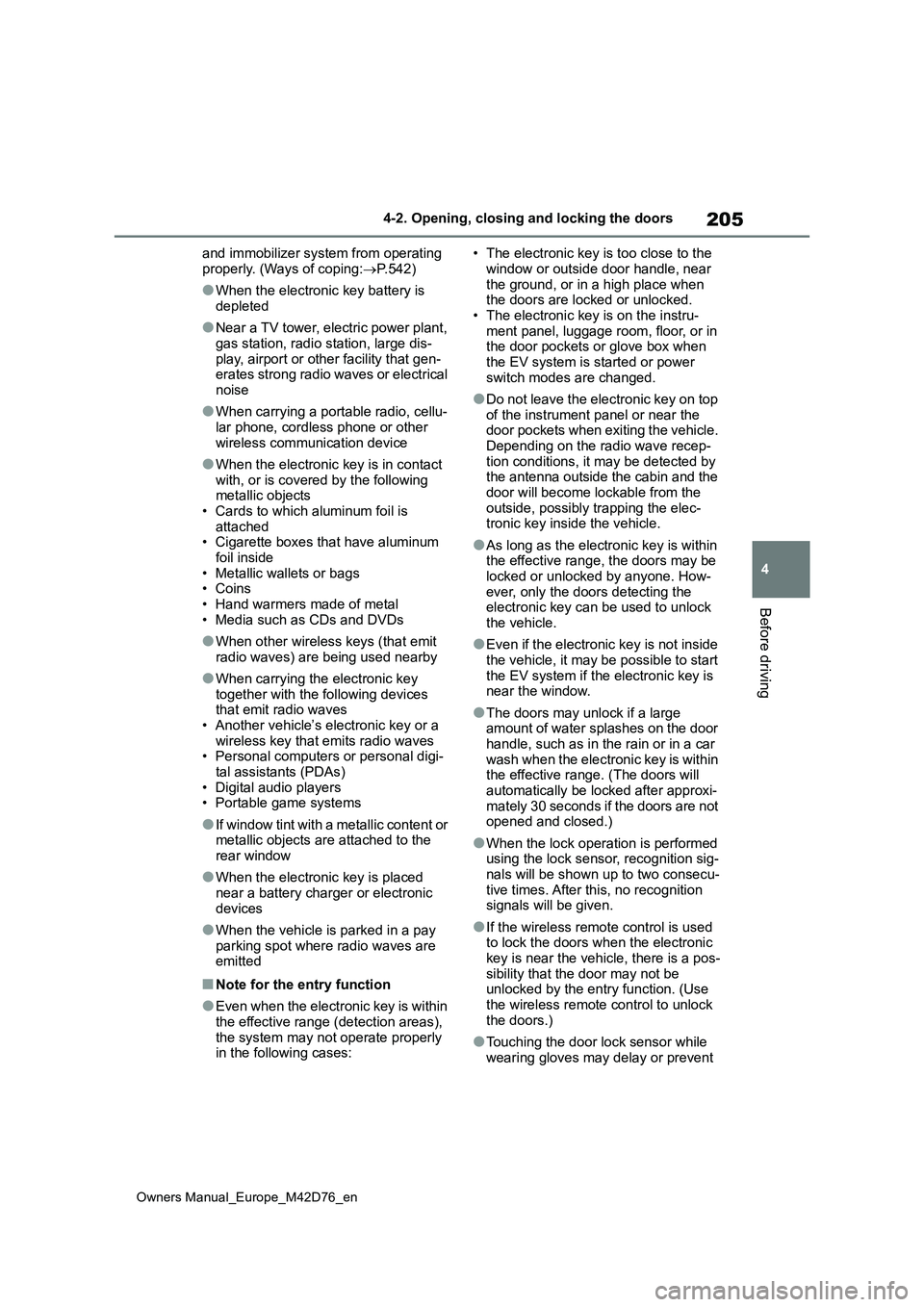
205
4
Owners Manual_Europe_M42D76_en
4-2. Opening, closing and locking the doors
Before driving
and immobilizer system from operating
properly. (Ways of coping: P.542)
●When the electronic key battery is
depleted
●Near a TV tower, electric power plant,
gas station, radio station, large dis- play, airport or other facility that gen-erates strong radio waves or electrical
noise
●When carrying a portable radio, cellu-
lar phone, cordless phone or other wireless communication device
●When the electronic key is in contact with, or is covered by the following metallic objects
• Cards to which aluminum foil is attached• Cigarette boxes that have aluminum
foil inside • Metallic wallets or bags• Coins
• Hand warmers made of metal • Media such as CDs and DVDs
●When other wireless keys (that emit radio waves) are being used nearby
●When carrying the electronic key together with the following devices that emit radio waves
• Another vehicle’s electronic key or a wireless key that emits radio waves• Personal computers or personal digi-
tal assistants (PDAs) • Digital audio players• Portable game systems
●If window tint with a metallic content or metallic objects are attached to the
rear window
●When the electronic key is placed
near a battery charger or electronic devices
●When the vehicle is parked in a pay parking spot where radio waves are emitted
■Note for the entry function
●Even when the electronic key is within the effective range (detection areas),
the system may not operate properly in the following cases:
• The electronic key is too close to the
window or outside door handle, near the ground, or in a high place when the doors are locked or unlocked.
• The electronic key is on the instru- ment panel, luggage room, floor, or in the door pockets or glove box when
the EV system is started or power switch modes are changed.
●Do not leave the electronic key on top of the instrument panel or near the door pockets when exiting the vehicle.
Depending on the radio wave recep- tion conditions, it may be detected by the antenna outside the cabin and the
door will become lockable from the outside, possibly trapping the elec-tronic key inside the vehicle.
●As long as the electronic key is within the effective range, the doors may be
locked or unlocked by anyone. How- ever, only the doors detecting the electronic key can be used to unlock
the vehicle.
●Even if the electronic key is not inside
the vehicle, it may be possible to start the EV system if the electronic key is near the window.
●The doors may unlock if a large amount of water splashes on the door
handle, such as in the rain or in a car wash when the electronic key is within the effective range. (The doors will
automatically be locked after approxi- mately 30 seconds if the doors are not opened and closed.)
●When the lock operation is performed using the lock sensor, recognition sig-
nals will be shown up to two consecu- tive times. After this, no recognition signals will be given.
●If the wireless remote control is used to lock the doors when the electronic
key is near the vehicle, there is a pos- sibility that the door may not be unlocked by the entry function. (Use
the wireless remote control to unlock the doors.)
●Touching the door lock sensor while wearing gloves may delay or prevent
Page 229 of 674
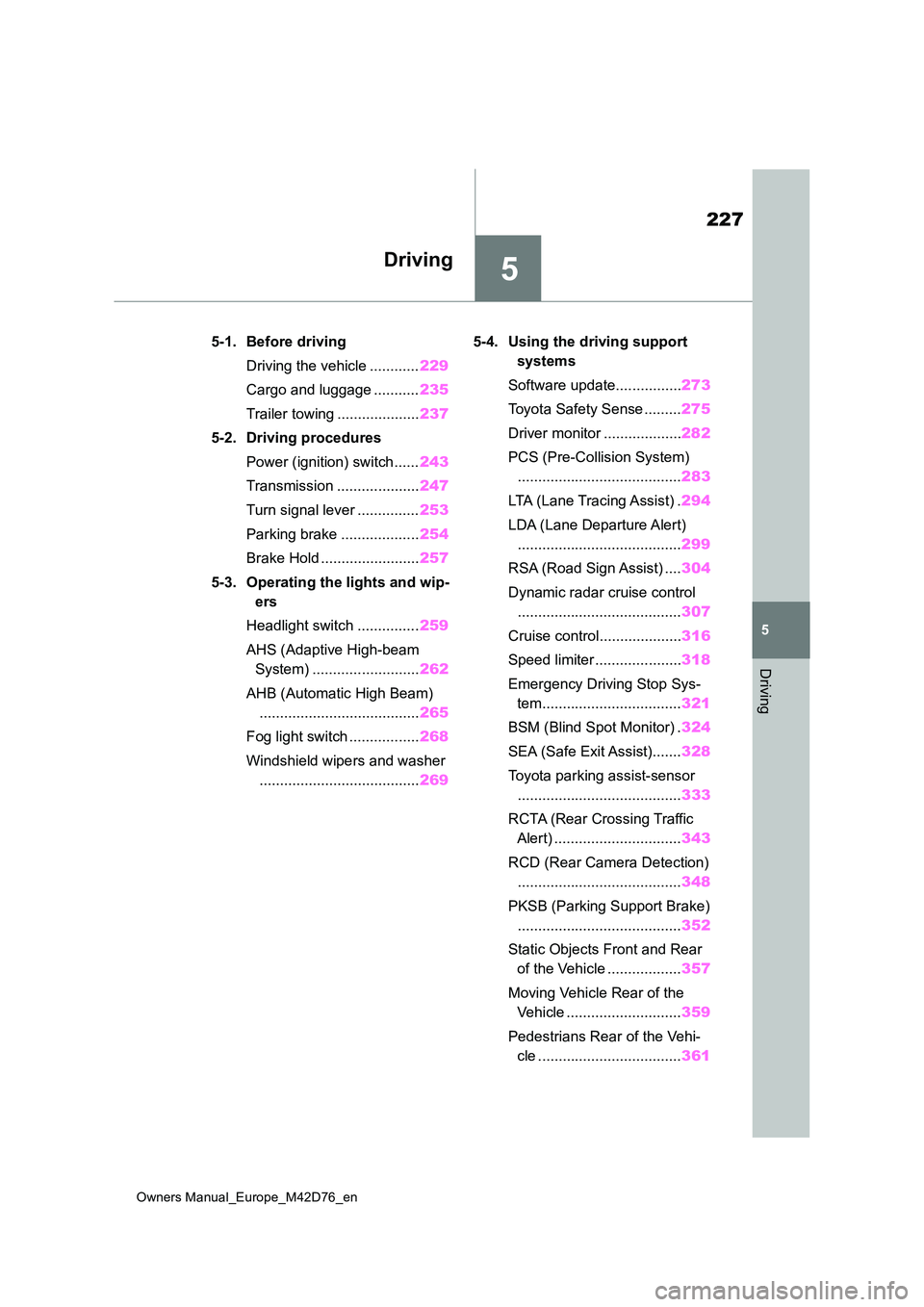
5
227
Owners Manual_Europe_M42D76_en
5
Driving
Driving
5-1. Before driving
Driving the vehicle ............ 229
Cargo and luggage ........... 235
Trailer towing .................... 237
5-2. Driving procedures
Power (ignition) switch ...... 243
Transmission .................... 247
Turn signal lever ............... 253
Parking brake ................... 254
Brake Hold ........................ 257
5-3. Operating the lights and wip-
ers
Headlight switch ............... 259
AHS (Adaptive High-beam
System) .......................... 262
AHB (Automatic High Beam)
....................................... 265
Fog light switch ................. 268
Windshield wipers and washer
....................................... 269
5-4. Using the driving support
systems
Software update................ 273
Toyota Safety Sense ......... 275
Driver monitor ................... 282
PCS (Pre-Collision System)
........................................ 283
LTA (Lane Tracing Assist) . 294
LDA (Lane Departure Alert)
........................................ 299
RSA (Road Sign Assist) .... 304
Dynamic radar cruise control
........................................ 307
Cruise control.................... 316
Speed limiter ..................... 318
Emergency Driving Stop Sys-
tem.................................. 321
BSM (Blind Spot Monitor) . 324
SEA (Safe Exit Assist)....... 328
Toyota parking assist-sensor
........................................ 333
RCTA (Rear Crossing Traffic
Alert) ............................... 343
RCD (Rear Camera Detection)
........................................ 348
PKSB (Parking Support Brake)
........................................ 352
Static Objects Front and Rear
of the Vehicle .................. 357
Moving Vehicle Rear of the
Vehicle ............................ 359
Pedestrians Rear of the Vehi-
cle ................................... 361
Page 230 of 674
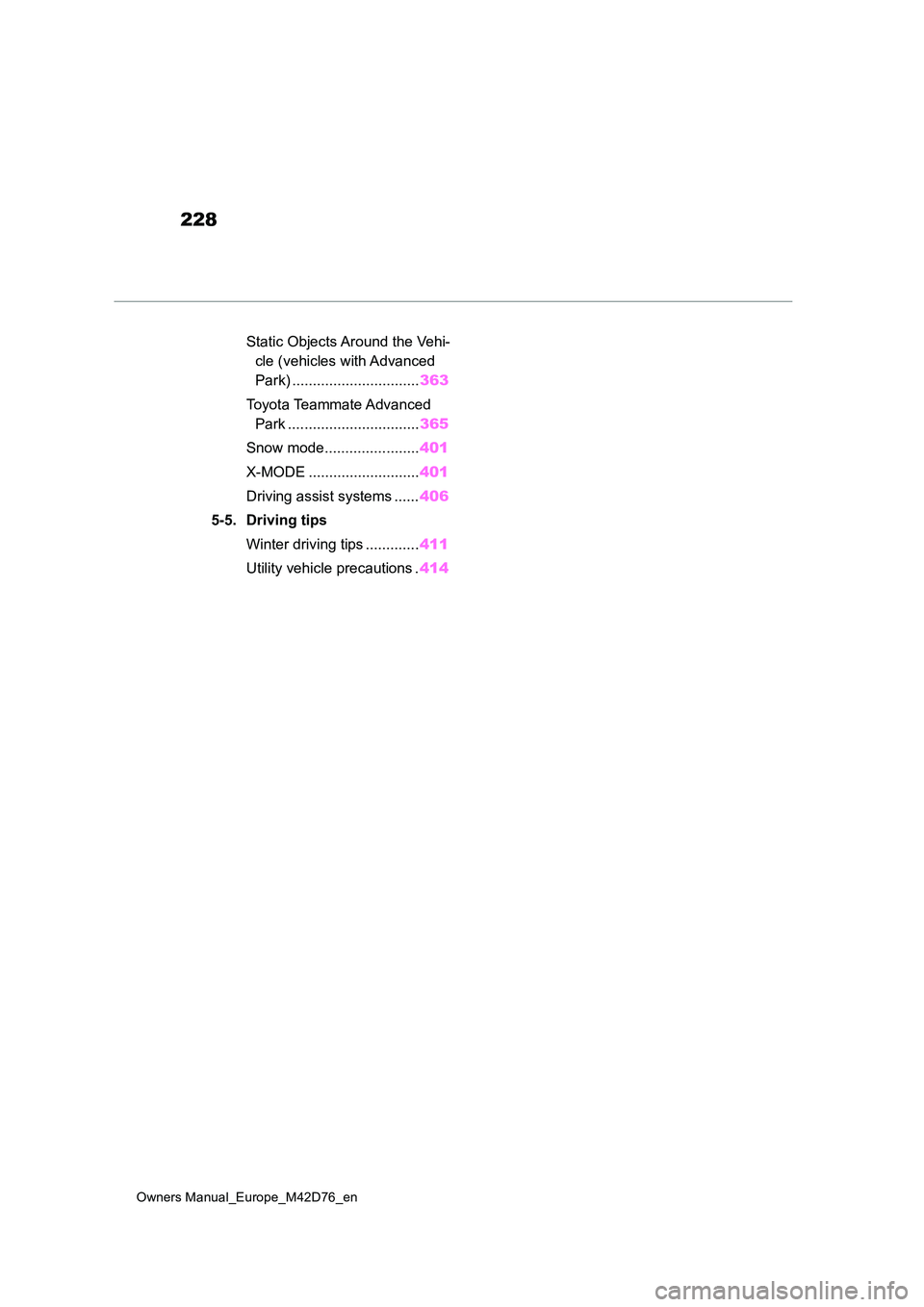
228
Owners Manual_Europe_M42D76_en
Static Objects Around the Vehi-
cle (vehicles with Advanced
Park) ............................... 363
Toyota Teammate Advanced
Park ................................ 365
Snow mode....................... 401
X-MODE ........................... 401
Driving assist systems ...... 406
5-5. Driving tips
Winter driving tips ............. 411
Utility vehicle precautions . 414
Page 231 of 674
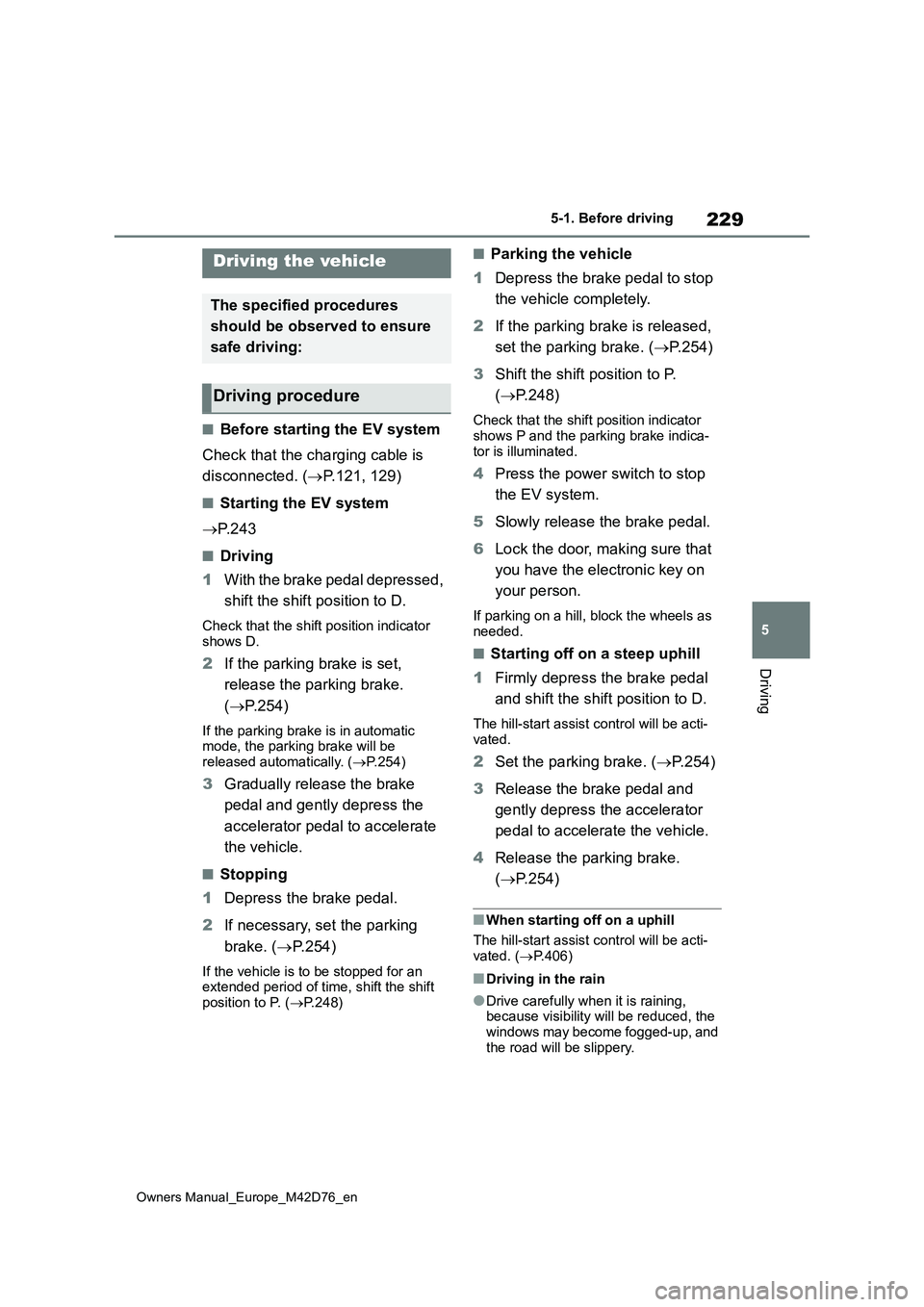
229
5
Owners Manual_Europe_M42D76_en
5-1. Before driving
Driving
5-1.Before driv in g
■Before starting the EV system
Check that the charging cable is
disconnected. ( P.121, 129)
■Starting the EV system
P. 2 4 3
■Driving
1 With the brake pedal depressed,
shift the shift position to D.
Check that the shift position indicator
shows D.
2 If the parking brake is set,
release the parking brake.
( P.254)
If the parking brake is in automatic mode, the parking brake will be released automatically. ( P.254)
3Gradually release the brake
pedal and gently depress the
accelerator pedal to accelerate
the vehicle.
■Stopping
1 Depress the brake pedal.
2 If necessary, set the parking
brake. ( P.254)
If the vehicle is to be stopped for an extended period of time, shift the shift position to P. ( P.248)
■Parking the vehicle
1 Depress the brake pedal to stop
the vehicle completely.
2 If the parking brake is released,
set the parking brake. ( P.254)
3 Shift the shift position to P.
( P.248)
Check that the shift position indicator shows P and the parking brake indica-
tor is illuminated.
4 Press the power switch to stop
the EV system.
5 Slowly release the brake pedal.
6 Lock the door, making sure that
you have the electronic key on
your person.
If parking on a hill, block the wheels as needed.
■Starting off on a steep uphill
1 Firmly depress the brake pedal
and shift the shift position to D.
The hill-start assist control will be acti-
vated.
2 Set the parking brake. (P.254)
3 Release the brake pedal and
gently depress the accelerator
pedal to accelerate the vehicle.
4 Release the parking brake.
( P.254)
■When starting off on a uphill
The hill-start assist control will be acti- vated. ( P.406)
■Driving in the rain
●Drive carefully when it is raining, because visibility will be reduced, the
windows may become fogged-up, and the road will be slippery.
Driving the vehicle
The specified procedures
should be observed to ensure
safe driving:
Driving procedure
Page 303 of 674

301
5
Owners Manual_Europe_M42D76_en
5-4. Using the driving support systems
Driving
• The steering wheel is not being turned
sufficiently to perform a lane change.*: Boundary between the asphalt and
grass, soil, etc., or structures, such as
a curb, guardrail, etc.
●Break suggestion function
This function is operable when all of the
following conditions are met:
• The vehicle speed is approximately 50 km/h (32 mph) or more.• The lane width is approximately 3 m
(9.8 ft.) or more.
■Temporary cancelation of functions
When the operating conditions are no longer met, a function may be temporar-
ily canceled. However, when the opera- tion conditions are met again, operation of the function will automatically be
restored. ( P.300)
■Operation of the lane departure alert function/lane departure pre-vention function
●Depending on the vehicle speed, road conditions, lane departure angle, etc.,
operation of the lane departure pre- vention function may not be felt or the function may not operate.
●Depending on the conditions, the warning buzzer may operate even if
vibration is selected through a cus- tomize setting.
●If a course* is not clear or straight, the
lane departure alert function or lane
departure prevention function may not operate.
●The lane departure alert function or lane departure prevention function may not operate if the system judges
that the vehicle is intentionally being steered to avoid a pedestrian or parked vehicle.
●It may not be possible for the system to judge if there is danger of a collision
with a vehicle in an adjacent lane.
●The steering assist operation of the
lane departure prevention function can be overridden by the steering
wheel operation of the driver.*: Boundary between the asphalt and
grass, soil, etc., or structures, such as
a curb, guardrail, etc.
■Hands off steering wheel warning
operation
In the following situations, a message urging the driver to operate the steering
wheel and an icon will be displayed and a buzzer will sound to warn the driver. When using the system, make sure to
grip the steering wheel firmly, regardless of whether the warning is operating or not.
●When the system determines that the driver is not securely holding the
steering wheel, or the steering wheel is not being operated when the steer-ing assist operation of the lane depar-
ture prevention function is operating
The length of time that the warning buzzer operates will become longer as
the frequency of the steering assist operating increases. Even if the system judges that the steering wheel has been
operated, the warning buzzer will sound for a certain amount of time.
■Break suggestion function
If the vehicle is swaying, a message will
be displayed and a warning buzzer will sound to urge the driver to take a break.
Page 320 of 674
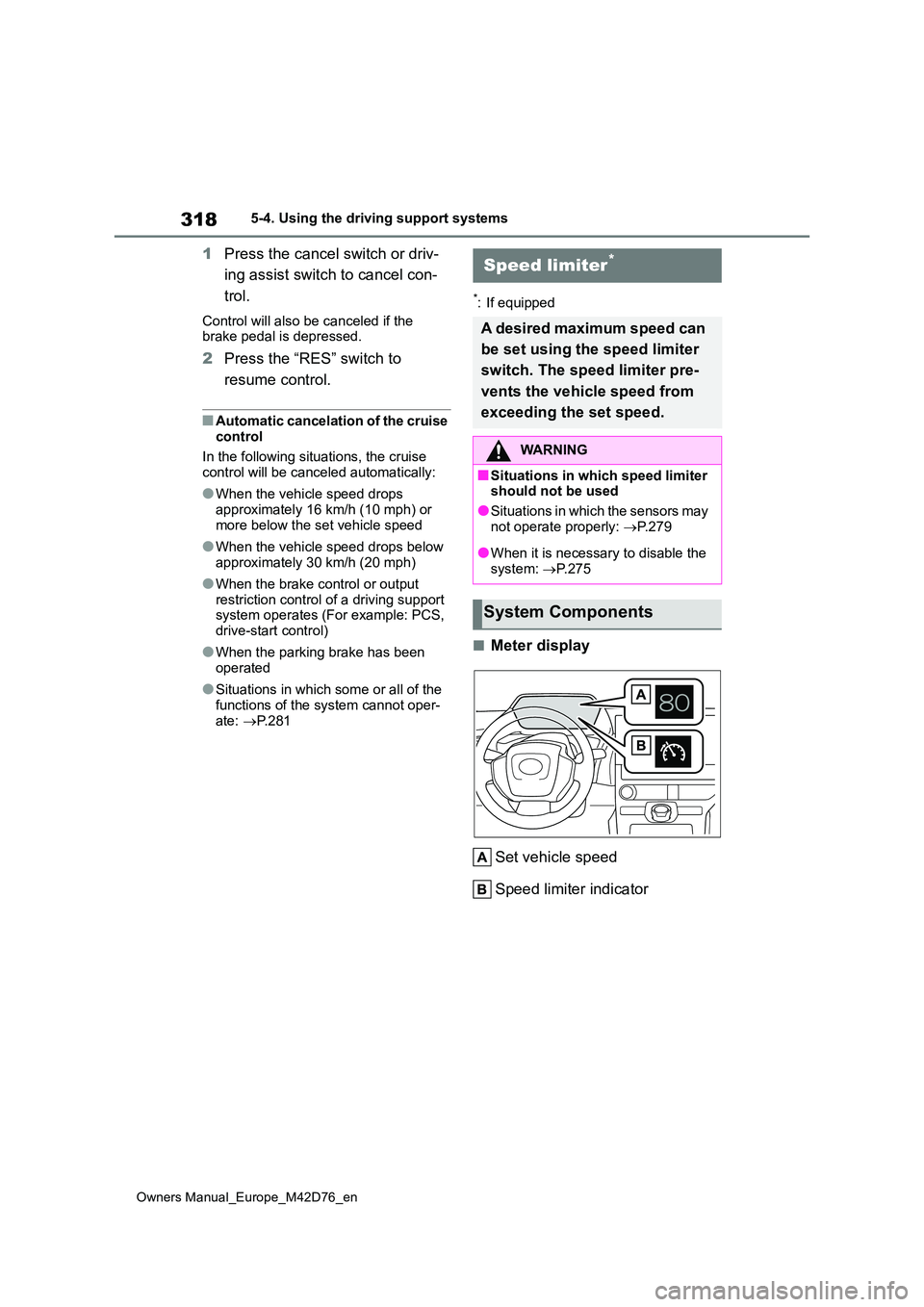
318
Owners Manual_Europe_M42D76_en
5-4. Using the driving support systems
1Press the cancel switch or driv-
ing assist switch to cancel con-
trol.
Control will also be canceled if the brake pedal is depressed.
2 Press the “RES” switch to
resume control.
■Automatic cancelation of the cruise
control
In the following situations, the cruise control will be canceled automatically:
●When the vehicle speed drops approximately 16 km/h (10 mph) or
more below the set vehicle speed
●When the vehicle speed drops below
approximately 30 km/h (20 mph)
●When the brake control or output
restriction control of a driving support system operates (For example: PCS, drive-start control)
●When the parking brake has been operated
●Situations in which some or all of the functions of the system cannot oper-
ate: P. 2 8 1
*: If equipped
■Meter display
Set vehicle speed
Speed limiter indicator
Speed limiter*
A desired maximum speed can
be set using the speed limiter
switch. The speed limiter pre-
vents the vehicle speed from
exceeding the set speed.
WARNING
■Situations in which speed limiter should not be used
●Situations in which the sensors may
not operate properly: P.279
●When it is necessary to disable the
system: P.275
System Components